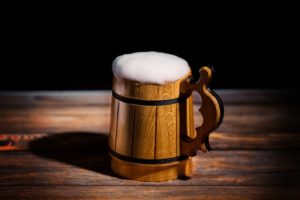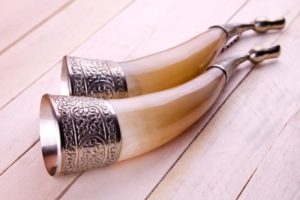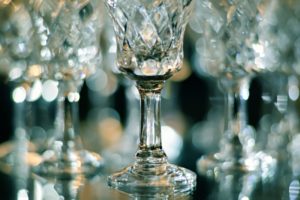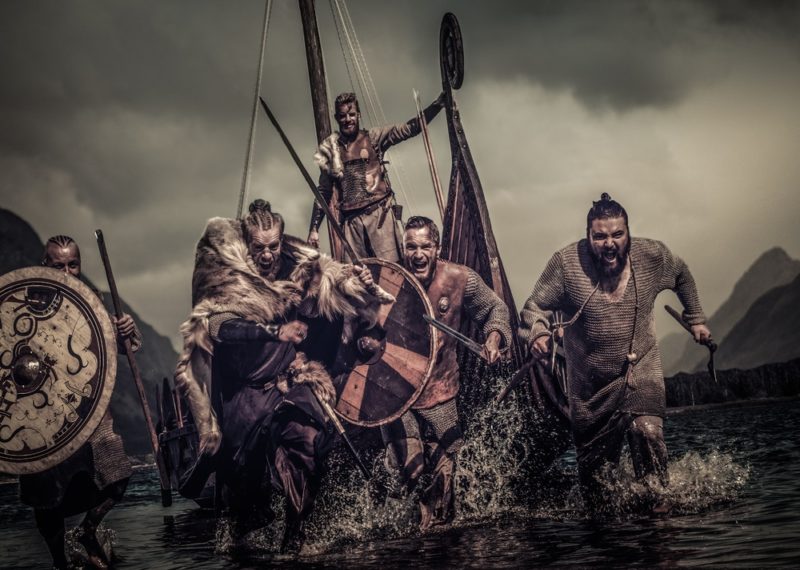The Vikings and Saxons employed glass in numerous ways, including window glass, drinking vessels, wine glasses, jewelry, Viking eyewear, enameling, and beads. Let’s take a look at the history of these handmade items in case you want a similar experience with Viking glass!
Viking Drinking Glasses
Glass was originally made in the Middle East around 5,000 years ago, most likely as a refinement of pottery glazes. The first blown glass was made in the Eastern Mediterranean in the first century AD. Glass blowing developed quickly throughout Europe, primarily within the Roman Empire. One of the first centers was in what is currently known as eastern France and Germany, along the Rhine Valley. When the first pieces began appearing in Scandinavia in the sixth and seventh century, additional expansion began across Europe.
During the Viking Age, between AD 800 and 1050, the cone beaker was the most frequent style of a glass vessel. Throughout archaeological finds in Denmark, Norway, Sweden, northern Germany, and other European locations, large quantities of Viking cone beakers have been discovered. Cone beakers of different sizes and forms have been discovered in women’s tombs at Sweden’s Björko (Birka).
Cone beakers with blue rims were discovered during Viking-era castle explorations in Trelleborg, Denmark.
The original glasses were most likely Frankish in design and were brought home by Viking raiders or traders. The form of the glasses is explained by Germanic drinking customs, which required drinking “bottoms up” before returning the glass to the table.
Mead and beer were consumed by the Vikings. Mead was and still is prepared with honey, making it a prized item in the Viking Age, and the beer drank in the medieval era was very different from what we drink now because it was produced with bogmyrtle rather than hops.
Drinking Horns
The drinking aurochs and cow horns are arguably the most emblematic and well-known Viking Age containers. They’re also portrayed in iconography and appear in literary records at feasts and rites. It goes without saying that such a vessel had a tight code of conduct regarding how, when, and by who it might be utilized. Some feasts may follow the drekka tvimenning rule (where a pair of drinkers share a common horn), for example, whereas the drinking and passing from the ruler’s horn may be interpreted as an oath-swearing ceremony; both circumstances suggest that horns were used at banquets to keep essential social bonds.
Viking Glass Uses
Monks used reading stones before the invention of glasses. These were essentially medieval magnifying glasses: it was previously assumed that these reading stones were largely the domain of monks, but a set of quartz crystal glasses was discovered in Viking graves in Visby, Gotland (Sweden). To be fair, Vikings were notorious for their penchant for ransacking monasteries.
They did, however, have trading ties, which we often overlook. Although rock crystal beads and incomplete lenses were discovered in Frojel in 1999, historians believed the lenses came from the Middle East or Byzantium, implying that they might have been made on Gotland. The amazing thing about these lenses is that they were made by folks who didn’t have any mathematical expertise and still believed that light came out of the eyes instead of into them.
They must’ve created these items solely through trial and error, and it’s thought that the know-how to do so was limited to only a few, if not one, artisans at the time.
Frequently Asked Questions (FAQs)
Did Vikings Use Glass?
The Vikings utilized glass in a variety of ways, including Viking eyewear, drinking vessels, jewelry, window glass, jewelry, enamel coating, and beads. Although glass objects have been discovered all throughout Europe, evidence of glass work has been discovered at Hedeby in northern Germany and Ribe in Denmark.
Did Vikings Have Glass Bottles?
Only a handful of Early medieval European bottles and flasks (Old Norse: flaska) made of glass, pottery, metal, wood, and leather have been discovered. The lack of locally produced anorganic bottles in Scandinavia indicates that organic products were mostly used.
What Did Vikings Drink Out of?
The Viking warriors hoped to drink from the skulls of whom they had slaughtered in Odin’s hall. Vikings drank from the horns of bulls or goats, as the name implies. Although few horns have been discovered, ornamental metal fittings have been discovered in considerable numbers to back up the literature evidence.







